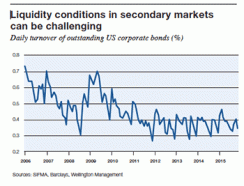To view a PDF of the full report click here.
Many investors assume that outperforming a market benchmark should be their main objective. This can only be true, though, if the benchmark is designed to meet the investor’s needs. Yet by ignoring credit quality, duration, volatility, diversification, and liquidity, traditional capitalization-weighted indexes generally do not incorporate the factors that really drive fixed income investment outcomes. In our view, an appropriate benchmark starts with a clear understanding of the investor’s objectives.
Many of the arguments against the use of cap-weighted indexes as portfolio benchmarks are familiar. The largest issuers are precisely the ones most heavily represented, even though high levels of indebtedness can have a negative impact on an issuer’s credit quality. Since the financial crisis, policy accommodation and quantitative easing by key central banks have further distorted the relative weightings of issuers in global indexes. The duration of broad-market indexes has been lengthening in recent years as interest rates remain low globally, spurring worries about capital losses as rates rebound.

These circumstances call for new forms of market exposure that are responsive to investors’ goals. Such goals could include a desire to fine-tune market exposure by consciously balancing risks; adoption of low-turnover strategies to reduce investment costs and enhance after-fee returns; and moving beyond rules-based approaches to build in forward-looking, fundamental insights.
To illustrate our belief that cap-weighted indexes can be improved upon, with reshaped market betas addressing all three goals cited above, we offer two examples from developed and emerging markets. These approaches, whose features are based on extensive empirical research, have the potential to deliver long-term returns similar to the standard indexes but with less volatility.
Many of the arguments against the use of cap-weighted indexes as portfolio benchmarks are familiar. The largest issuers are precisely the ones most heavily represented, even though high levels of indebtedness can have a negative impact on an issuer’s credit quality. Since the financial crisis, policy accommodation and quantitative easing by key central banks have further distorted the relative weightings of issuers in global indexes. The duration of broad-market indexes has been lengthening in recent years as interest rates remain low globally, spurring worries about capital losses as rates rebound.
Furthermore, the post-crisis era has seen a significant constriction in secondary-market liquidity. Though liquidity pressures are most pronounced in credit markets, they have also surfaced in the market for government bonds, as evidenced by the “flash crash” of 15 October 2014 in US Treasuries. Investment strategies that seek to track a cap-weighted index are compelled to trade securities each time the index rebalances in order to achieve their objective. Such “forced” transactions can unnecessarily impair after-fee returns under normal conditions, and be even more costly in periods when market liquidity conditions are stressed. The annual cost of rebalancing can be meaningful. For example, Barclay’s Liquidity Cost Score estimates the cost of executing a round-trip trade in US investment-grade credit as of 31 December 2015 to be 0.83%. (See chart.)
These circumstances call for new forms of market exposure that are responsive to investors’ goals. Such goals could include a desire to fine-tune market exposure by consciously balancing risks; adoption of low-turnover strategies to reduce investment costs and enhance after-fee returns; and moving beyond rules-based approaches to build in forward-looking, fundamental insights.
To illustrate our belief that cap-weighted indexes can be improved upon, with reshaped market betas addressing all three goals cited above, we offer two examples from developed and emerging markets. These approaches, whose features are based on extensive empirical research, have the potential to deliver long-term returns similar to the standard indexes but with less volatility.
Improving Emerging Local Debt Beta With Systematic, Research-Based Tilts
Evan Ouellette Fixed Income Portfolio Manager
Robert Fuhrman Director, Fixed Income Quantitative Research
In contrast to traditional cap-weighted indexes for emerging local debt (ELD), this strategy seeks to emphasize areas of the market that have demonstrated higher returns for the level of risk taken in investing in such areas. The approach adopts structural tilts, based on extensive empirical research on historical return patterns, such as the following:
- Emphasis on intermediate-duration over long-duration bonds. Intermediate-maturity securities appear generally to have offered more reward per unit of risk historically than long maturities across the world’s bond markets. While long-duration bonds may make sense for the domestic investor with long-term domestic liabilities, the non-domestic investor bears significantly higher risk with little to no compensation for that extra risk.
- Tilt towards high-carry versus low-carry currencies. Academic studies have clearly demonstrated that currencies with high carry – that is, relatively high short-term interest rates – produce greater home-currency returns (interest plus currency effects) than low-carry currencies.
- Mitigation of currency risk through nuanced hedging. ELD indexes are typically either fully hedged to currency risks or not hedged at all. However, one can selectively reduce risk by hedging out certain currencies where there is no expectation of return.
- Diversification of country exposures. Country exposures in traditional ELD indexes, as in their developed market counterparts, are concentrated in the most indebted issuers. More balanced approaches can lessen risk through greater market diversification.
A Discretionary, Research-Based Approach to Improving Investment Outcomes in Global Government Bonds
Mark Sullivan, CFA, CMT, Fixed Income Portfolio Manager
John Butler, Global Bond Strategist
This unlevered, benchmark-agnostic strategy seeks to capture the benefits that government bonds have historically provided to a portfolio — diversification, liquidity, a hedge against low economic growth and disinflation — through a discretionary investment process, enhanced diversification, and a focus on downside risks.
- Credit risk: Our approach breaks out the analysis of credit risk into components. The process starts with data feeds into our proprietary Sovereign Risk Framework, which generates a sovereign credit score and corresponding rating for over 20 countries. We also tap the firm’s broader research platform and our country specialists’ knowledge to understand an issuer’s short-term, cyclical dynamics. As a final step, we overlay these sovereign scores on top of current market pricing to assess valuations.
- Interest-rate risk/duration management: We use our strategists’ global cycle research to gauge whether the strategy should be in return-seeking (longer duration) or capital-preservation (shorter duration) mode. Currently, we believe markets are in the early stages of a rising-interest-rate cycle which will likely be led by the US. Hence, we think it is prudent to lower duration in order to mitigate capital losses.
- Currency risk: The high degree of volatility expected from unhedged currency exposure is typically undesirable for government bond investors. Non-home currency exposure is therefore hedged back to the portfolio’s base currency.
For more details, please visit:
www.wellington.com/strat_gov_bonds and www.wellington.com/smarter_ELD
Contact:
Ryan Randolph: 1-617-951-5894 rprandolph@wellington.com
This material and/or its contents are current at the time of writing and may not be reproduced or distributed in whole or in part, for any purpose, without the express written consent of Wellington Management. This material is not intended to constitute investment advice or an offer to sell, or the solicitation of an offer to purchase shares or other securities. Investors should always obtain and read an up-to-date investment services description or prospectus before deciding whether to appoint an investment manager or to invest in a fund. Any views expressed herein are those of the author(s), are based on available information, and are subject to change without notice. Individual portfolio management teams may hold different views and may make different investment decisions for different clients. FOR INSTITUTIONAL INVESTORS ONLY





